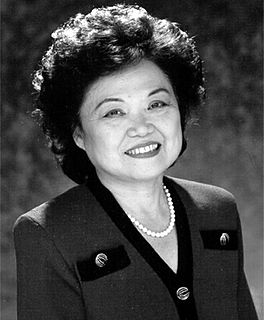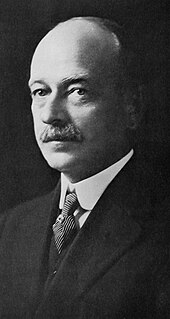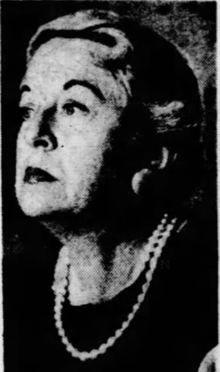
Scouting in Hawaii began in the 1900s. It serves thousands of youth in programs that suit the environment in which they live.

Linda Lingle is an American politician,who was the sixth governor of Hawaii from 2002 until 2010. She was the first Republican governor of Hawaii since 1962. Lingle was also the state's first female and first Jewish governor. Prior to serving as governor,Lingle served as Maui County mayor,council member,and chair of the Hawaii Republican Party.

Patsy Matsu Mink was an American attorney and politician from the U.S. state of Hawaii. Mink was a third-generation Japanese American,having been born and raised on the island of Maui. After graduating as valedictorian of the Maui High School class in 1944,she attended the University of Hawaii at Mānoa for two years and subsequently enrolled at the University of Nebraska,where she experienced racism and worked to have segregation policies eliminated. After illness forced her to return to Hawaii to complete her studies there,she applied to 12 medical schools to continue her education but was rejected by all of them. Following a suggestion by her employer,she opted to study law and was accepted at the University of Chicago Law School in 1948. While at university,she met and married a graduate student,John Francis Mink. When they graduated in 1951,Patsy Mink was unable to find employment and after the birth of their daughter in 1952,the couple moved to Hawaii.

Henry Alexander Baldwin or Harry Alexander Baldwin was a sugarcane plantation manager,and politician who served as Congressional Delegate to the United States House of Representatives representing the Territory of Hawaii. He was one of the earliest leaders of the Hawaii Republican Party.

Theresa Owana Kaʻōhelelani Laʻanui was a descendant of Kalokuokamaile,the eldest brother of Kamehameha I. She was a member of the House of Laʻanui,a collateral branch of the House of Kamehameha.

Abigail Helen Kapiʻolani Kawānanakoa was a member of the House of Kawānanakoa and the eldest daughter of Prince David Kawānanakoa and Princess Abigail Campbell Kawānanakoa.
Hawaii Superferry was a Hawaii-based transportation company that provided passenger and vehicle transportation between Honolulu Harbor on the island of Oʻahu and Kahului Harbor on Maui. Legal issues over environmental impact statements and protests from residents of Maui and Kauaʻi temporarily delayed the implementation of service,but service between Oʻahu and Maui began in December 2007. The company had hoped to return service to Nawiliwili Harbor on Kauaʻi and additionally planned to eventually provide service to Kawaihae Harbor on the Big Island.

Elizabeth Kahanu Kaʻauwai Kalanianaʻole Woods was the wife of Prince Jonah KūhiōKalanianaʻole,Hawaii's second delegate to Congress.

William Hyde Rice was a businessman and politician who served in the Kingdom of Hawaii,during the Kingdom's Overthrow,and in the following Republic of Hawaii and Territory of Hawaii governments. He collected and published legends of Hawaiian mythology.

Kapiʻolani was the queen of the Kingdom of Hawaiʻi as the consort of Mōʻī(king) Kalākaua,who reigned from 1874 to 1891 until Mōʻī's death when she became known as the Dowager Queen Kapiʻolani. Deeply interested in the health and welfare of Native Hawaiians,Kapiʻolani established the Kapiʻolani Home for Girls,for the education of the daughters of residents of the Kalaupapa Leprosy Settlement,and the Kapiʻolani Maternity Home,where Hawaiian mothers and newborns could receive care.

William Pūnohuʻāweoweoʻulaokalani White was a Hawaiian lawyer,sheriff,politician,and newspaper editor. He became a political statesman and orator during the final years of the Kingdom of Hawaii and the beginnings of the Territory of Hawaii. Despite being a leading Native Hawaiian politician in this era,his legacy has been largely forgotten or portrayed in a negative light,mainly because of a reliance on English-language sources to write Hawaiian history. He was known by the nickname of "Pila Aila" or "Bila Aila" for his oratory skills.

Rosalie Enos Lyons Keliʻinoi was a Portuguese-Native Hawaiian politician of the Territory of Hawaii. In 1925,she became the first woman elected to the Hawaii Territorial Legislature,representing the island of Kauai.

Emilie Kekāuluohi Widemann Macfarlane was a Native Hawaiian activist and civic organizer during the late 19th and early 20th centuries She was known for her charitable work and civic involvement in Honolulu,including women's suffrage,public health,education,and the preservation of Hawaii's historical legacy.

Beatrice Majors Van Vleet Burns was the First Lady of Hawaii for three terms. Born in Oregon and raised in numerous states,she became a Registered nurse,joined the United States Army Nurse Corps,and moved to Hawaii. She met Hawaii's future governor John A. Burns during a picnic at Hanauma Bay,when he was a college student. Together they had four children,one of which was born premature and died when she was struck by poliomyelitis. She never fully recovered from her paralysis,but lived a full life as a wife and mother. During her tenure as the First Lady of Hawaii,she restored the governor's residence of Washington Place.

Anna Kuulei Furtado Kahanamoku was a Hawaiian teacher who became an elected member of the Hawaii Territorial House of Representatives from the Fourth District,and after Hawaii was admitted to statehood,she served in the Hawaii Senate.

William Kamau was an American clergyman,and the second Kahu (shepherd) of Hawaiian ancestry at Kawaiahaʻo Church in Honolulu,Hawaii.

Elsie Hart Wilcox was the first woman to serve in the Senate of the Territory of Hawaii. Dedicated to public service,she rose up through the Mokihana Club on Kauai prior to the 19th Amendment to the U.S. Constitution giving women the legal right to vote in 1920. She was the descendant of missionaries who arrived in Hawaii during the 19th century,and was the sister of pioneer nurse Mabel Wilcox. Although born into an economically privileged family,she spent her adult life championing public school teachers,and volunteering in community services.

Mary Haʻaheo Atcherley was a Hawaiian activist. She was one of the first native Hawaiian women to run for public office in the Territory of Hawaii.

Thelma Alice Kalaokona Moore Akana Harrison was an American public health nurse and politician who served as a Republican Senator for Oahu in the Hawaii Territorial Legislature. She was the first woman to be reelected to the Territorial Senate.

Flora Kekulalani Kaai Hayes (1893–1968) was a Hawaiian-American politician and actor. She served in the Hawaii Territorial House of Representatives for seven terms between 1938 and 1959,representing Oahu as a member of the Hawaii Republican Party. From the 1920s through the early 1930s,Hayes became involved in various Hawaiian organizations. In 1936,she was elected president of the Territory of Hawaii's parent–teacher association (PTA),serving two terms. At the request of John Ford,she stopped in Hollywood while traveling back from a PTA conference in Virginia to play a minor role in the 1937 film The Hurricane.




















